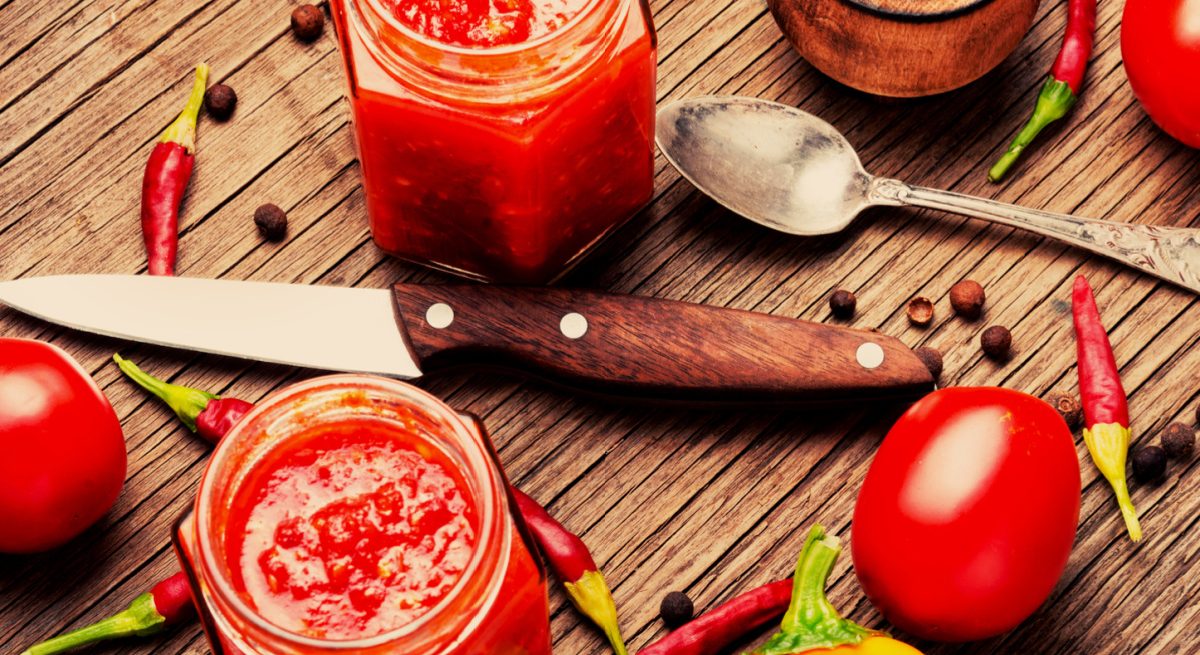How to Add Products to Your Restaurant’s Sales Mix
7 Min Read By Lauren Fernandez
The outlook is improving for many restaurants as COVID-19 restrictions loosen and guests make their way back to their favorite establishments. But the lingering effects of the pandemic continue to make this a challenging time for our industry as ongoing staffing issues and supply chain disruptions, in many cases, lead to reduced menus and shorter hours of operation.
So what can restaurant operators do to add to their bottom line, create cost savings and generate brand awareness? One option is to develop and manufacture products that can be used and sold in the restaurant as well as in retail outlets.
Product development is not quite as simple as just bottling your signature marinara sauce and upselling it at your front counter. The playbook for adding product lines to your restaurant sales mix is not so immediately obvious. There’s a lot that happens behind the scenes to get that bottle of your secret seasoning mix into hands of your guests or onto big-box shelves.
The process can be a little intimidating. But the good news is: it can be done.
Identify the Winner on Your Menu
The first step, of course, is figuring out what you want to sell. Often, we look for bottlenecks in production: where an item is custom, requires skilled labor and is used in large quantities on the menu. Other ways to source the key products to manufacture: What’s the most popular item on your menu—that one dish that you’re known for? What are your guests always ordering extra on the side? What dish gets the most mentions on Instagram, Yelp or Google? Is it a signature dish, a dry rub or a certain seasoning?
Most importantly, you want to find a product that is proprietary and something that is unique and special to your menu. That’s your product.
How Much Does It Cost to Make?
Once you know what your product is, cost out the recipe as you currently make it. Don’t forget to account for labor: is there a high labor cost attached to it? Does it involve skilled labor? Hours of preparation? Factor in everything you can think of that goes into producing it to help develop a theoretical cost for the product, including packaging.
Estimate Your Demand and Volume
Next comes figuring out how much to make. There are a number of factors to consider when estimating the manufacturing batch size for a product. First, take stock of normal in-house use in the kitchen – consider how frequently are you making batches in your own restaurants. Then, consider how much demand there may be for the product at retail, both in your restaurants and at local retailers. Finally, consider making sure your product has maximum shelf-life. Many natural preservatives are available to add shelf stability to a product.
Answering these questions will help determine what kind of volume you can (and should) aim for. Generally, aspirational sales goals should not count towards your initial batch size. Figuring out volume also often dictates what kind of manufacturing process and partner you’ll be looking for.
Find a Co-Packer to Manufacture
Most restaurant operations, unless they have 100 stores or more, use what’s called a co-packing manufacturer—a manufacturing company that makes, packages and stores your product for you. For most small to medium sized businesses, co-packers are far more economically viable than capital expense on machinery, manufacturing expertise, and warehousing. Co-packers are a wonderful partner in providing not only their expertise in developing recipes for scale but also valuable time on their existing manufacturing and packaging lines.
That exercise in product volume and shelf life we just did is vital to know before you shop for co-packer. How large a run you’re asking a co-packer to produce at one time affects how much they will charge you to do it.
Some co-packers charge a one-time set-up fee to create your product for the first time—establishing the procedures they’ll need to follow, figuring in any special equipment they’ll need to retrofit or custom tool, and the like. Then you can do three, four or however many runs a year at a lower cost, assuming you have the demand for volume.
Sometimes, in these situations, it can pay to wait. If you don’t have to do a run every week or every month and you can afford to be flexible, some co-packers may offer a bit of a discount. Of course, larger batches will achieve better economies of scale, but the product should have high demand or good shelf-life. You may pay for warehousing fees, but only until your demand grows to move product faster. Dialing in on this balance of shelf life, batch size and warehousing costs is a constant balance. Again, always monitoring your level of demand is key: monitor your consumption and sales at least monthly.
Research and Development
As part of the set-up process, the manufacturer or co-packer may go through several iterations of test batches of the recipe with you. This part of the process is absolutely critical. Recipes you use in a kitchen rarely if ever are ready to go to machined lines. Of course, the goal is to make sure the finished product is as close to the original product as possible. Always bring to the taste tests an original, hand-made sample to test against the machined recipe and product.
All kinds of things can change the way your sauce or mix feels or tastes during the process. Likewise, adding preservatives and the like for shelf-stability can affect the texture, viscosity or taste of the finished product. Tasting your product right off the line is an important part of this process.
And if your product has a secondary cooking process as part of its intended use, such as a marinade, then you’ll also want to take it through the process of marinating something in it and cooking it. Take the test version and an original hand-made product to your kitchen and test them both on the finished product. The goal is to experience the finished product the same way your customer ultimately will and to make sure it lives up to your quality standards.
If there are certain certifications you want your product to have, that can affect your choice of manufacturer as well. If it’s a kosher or halal product, there are strict guidelines the manufacturer has to follow. And for gluten-free or vegan—make sure your manufacturer is set up to follow all appropriate guidelines necessary to obtain the certification you need. Most manufacturers have ISO certifications or similar which indicate their adherence to strict food safety protocols.
Packaging and Design
So many people get caught up in shopping for and designing packaging well before they find a manufacturer. The truth is, this part of the process comes after you choose a manufacturer. It’s wholly dependent on the kind of bottling and labeling equipment they already have in place. You don’t want to start picking out bottles and jars ahead of time until you know who will be your co-packer.
A good co-packer should assist you in package selection, label design and making sure the package and label comply with the nutritional and labeling laws and regulations for the USDA and FDA. In some cases, if the type of packaging is critical, such as single-use tear packs, you may have to arrange for the co-packer to deliver the manufactured product to a specialty finish packaging company.
Quality Control, Legal and Insurance
These last steps require certain expertise and skilled professionals to help you.
Once your final product has been delivered, you’ll want to perform quality assurance on certain batches to help ensure that each batch is consistent. You’ll also want to set aside part of every batch (maybe half a case) in the event there is a claim that your product is tainted later. Keep detailed records and consult with counsel for best practices on record retention for quality control as well as complaint record keeping.
It’s also important to have a complaint and return procedure in place before you begin selling so that you can respond in a timely, responsible and legal manner in the case of an allergic reaction or foodborne illness. You may have requirements to report certain issues to health authorities, so make sure to retain good counsel skilled in product development and liability issues.
Always consult with counsel and an insurance specialist to make sure you have good general liability insurance with specific additional riders for situations like a product recall or a foodborne illness.
Getting into Retail
Once you have your impeccably designed jar of awesome sauce or special seasoning mix, you want to get it into the hands of your customers in as efficient a manner as possible. Pushing a product out to retail does have lower profit margins than wholesale or direct sale, but it pays returns in marketing your brand. First and foremost, you can sell your new product lines in your restaurant and similarly push them through your franchise system, if applicable.
But if you aim to broaden your reach, know that the way these products are distributed to other sellers is very different. Retail has a series of hoops you’ll need to jump through, whether you’re looking to place your product in a grocery store, a local vendor or a big-box retailer. Getting into those big-box stores can be very expensive with shelving or slotting fees, promotional costs, advertising fees and more.
Often the best thing to do is to find an experienced broker or salesperson to help you get into these locations. Make sure you find someone intimately familiar with the kind of space you’re looking to conquer. Brokers often come with up-front fees and commissions, so think carefully about how you want to spend your money to help you get into those spots.
Return on Investment
Product development can be a lot of work, but they can be a critical revenue source to a rapidly-growing restaurant brand. The use of manufacturing can create cost efficiencies and quality control within a restaurant system, especially if franchised. Packaging some of that manufacturing volume for retail can add to the bottom line, foster at-home brand interaction and overall, promote brand awareness in the larger marketplace outside the trade area of the restaurant.
From an investment standpoint, while there is capital outlay to embark on product development, there is significant immediate and ongoing returns. When one considers consumer packaged good product lines also get their own valuation, apart from the restaurants themselves – frankly, every growing restaurant brand must get on the product development track. It can be done. And you should do it.


